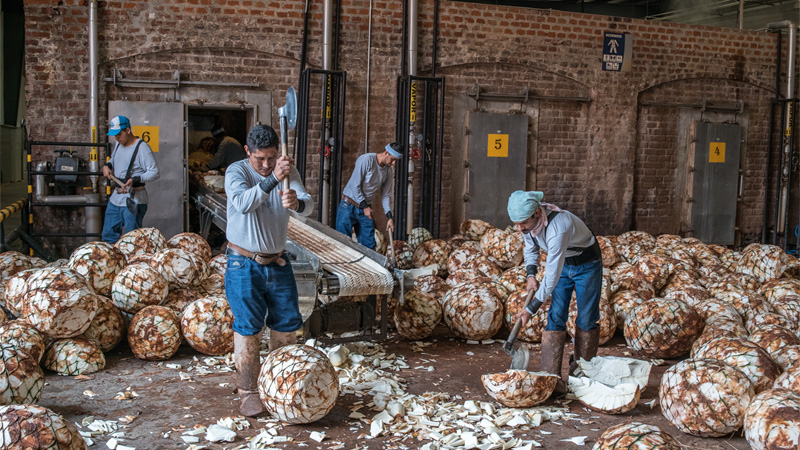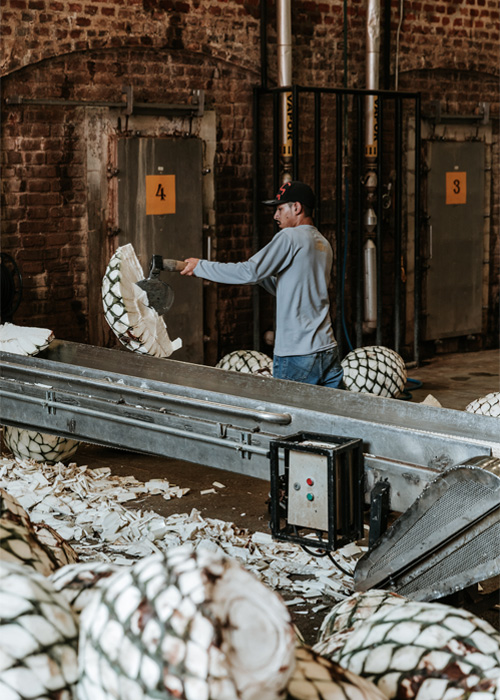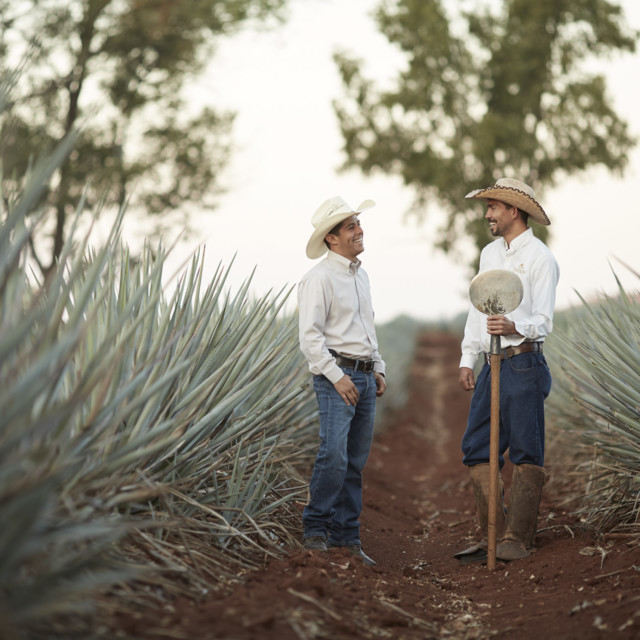
This article is part of a series, highlighting the importance of additive-free and authentic tequila, partnered by PATRÓN. Discover more at The World of PATRÓN.
Think about when you’re trying to cook the meal of your life. How you’ll buy the highest-quality, farm-fresh ingredients. How you’ll meticulously prep the proteins and produce. Then, how you’ll use a slow, deliberate cooking process to coax the most complex flavors out of each ingredient before beautifully plating the meal. In a way, a similar strategy is employed when it comes to producing tequila.
“Tequila is, in my point of view, the most fascinating spirit,” says Antonio Rodriguez, PATRÓN’s director of production.
Unfortunately, that fascinating potential is all too often corrupted. Despite the dozens of new tequila brands that have cropped up over the years, many of these names are made in the same handful of distilleries. There, generic producers create a base distillate style that is simply tweaked from brand to brand. This means that many companies are working with the same flat liquid, which is only slightly altered to drive differentiation. The worst part? Those “alterations” are often made by inserting additives — like artificial flavorings or chemicals — that are almost never listed on the label.
Today, tequila brands can add up to 1 percent of any ingredient to an expression without disclosing what’s been used, and still call the spirit “100 percent agave.” This allows large-scale producers to “customize” their spirits from brand to brand through the quick use of chemicals, and has led many to prioritize speed and convenience over anything else.
Just as kitchen gadgets like microwaves and pressure cookers offer home chefs accelerated prep time, often at the expense of flavor, technological advances in tequila production have provided shortcuts for producers to get to a finished product quicker. While that sounds like a lifesaver, in fact, it has led many to sacrifice flavors, complexities, and, most importantly, integrity.
“If you taste many different tequilas from many different producers, you sort of develop a facility of what the natural range of aromas and flavors are,” claims Clayton Szczech of Experience Agave. “When you taste something that is completely outside of that, that’s sort of a red flag for me.”

The following are just a few of the shortcuts that some brands currently take to try and speed up the tequila-making process.
Adding Sugar
Believe it or not, producers are legally permitted to add up to 1 percent by volume in additives to non-blanco tequilas without disclosing that information or even including it on their labels. Thus, a lot of people do not realize that a majority of tequila brands add sugar syrup or “jarabe” to their reposado and añejo releases in order to mask the mistakes they made in the production process, specifically, in rushing to harvest agave that is not fully mature and thus lacking in a high enough sugar content. This jarabe can be made of agave nectar, corn syrup, cane sugar, aspartame, sucralose (Splenda), or stevia. “The level of sweetness on the tequila can be developed in the slow cooking process with brick ovens, like PATRÓN does to develop a much sweeter profile than an autoclave which some other distilleries may use,” explains Rodriguez, “getting sweeter tequila without additives, means a low and slow cooking process, it can’t be rushed.” Rodriguez cites the giant steel tubes found in other distilleries that use high steam pressure to rapidly cook numerous agave. PATRÓN has no need for this shortcut because it carefully cultivates the finest 100 percent Weber Blue agave, fully mature, with a specifically high sugar content, and doesn’t use shortcuts like autoclaves — meaning it produces an exceptionally smooth flavor without the need for added sugar.
Other Additives
Besides sugar, imperfections are likewise sometimes masked by chemicals or oak extract. Just like in the food world, these additives are utilized to create uniformity in flavor and color from batch to batch. Since these additives are so extremely concentrated, even a few drops — well less than 1 percent of overall volume — is capable of radically changing the color, flavor, aroma, and texture of a tequila. These additives are frequently used to mask the lack of complexity that can arrive from the use of time-saving or cost-saving measures in the production process. “A combination of diffuser [a basketball court-sized machine that extracts agave starches using high-pressure water] and column stills will give you the best efficiency on alcohol transformation and the fastest process but also make for a less complex profile” that will be rendered watery and “thin” explains Rodriguez. In this case, adding glycerin, a natural byproduct of fermentation and distillation, can lend a more rounded mouthfeel to these quickly made tequilas. Likewise, caramel coloring can make a blanco look like an añejo. Thankfully, when you’re drinking PATRÓN you’re tasting pure tequila, additive-free, and completely delicious.
Over-Aging
If most shortcuts are meant to speed up the process of going from planted agave to packaged bottle, the final shortcut many brands utilize actually adds more time to the process: the over-aging of the liquid to create flavors that cover up flaws. While barrel-aging time is often seen as a positive in the whiskey industry, in the world of tequila that’s not necessarily the case. PATRÓN actually ages each of its tequilas on the shorter end of the age range for the category. The reason that some other brands age their tequila longer is because they are masking some of the imperfections in their base spirit, knowing full well that barrel character, with its notes of vanilla, coconut, and caramel, will cover up any flaws. Some say the barrel adds as much as 90 percent of the flavor to a spirit, which is not ideal for a liquid as delicate as tequila. (Even more unscrupulously, some brands will use oak extracts to make their tequilas smell or taste as though they were aged longer than they actually were.) When the production process is done the correct way, however, like it is at PATRÓN, the base spirit of silver tequila does not need more time in the barrels — it already tastes incredible. As Rodriguez says, “Tequila is so complex that sipping something that is not exploiting or showing this complexity is almost a waste of time.”

As a pioneer of the ultra-premium tequila category, PATRÓN has used time-honored artisanal processes and remained strictly additive-free. What that means is that every single drop of PATRÓN is made with only the highest-quality 100 percent Weber Blue agave. Each plant requires around seven years to reach full maturity before it can be hand-harvested by skilled jimadors. PATRÓN’s team then takes great care to find and uproot only those with an optimal sugar content, trimming them as close to the heart as possible.
The piñas (the heart of the agave) are roasted in small brick ovens for 72 hours, an unusually long time, which assures they are cooked evenly and helps bring out the more complex flavors of the agave. After that, it is crushed; PATRÓN uses many old-fashioned methods, including the ancestral Tahona method, which is when a two-ton volcanic stone wheel is used to separate the sweet juice from the pulp.
The resulting mixture is fermented in wood for three days, then distilled in handmade copper stills smaller than most in the tequila industry as it allows the spirit to get the best interaction. This even extends to the aging process, whether for the brand’s Reposado, Añejo, Extra Añejo, or coveted Extra Añejo 10 Años. Each of these expressions is matured in handmade barrels from a minimum of two months all the way up to 10 years.
Because of this incredibly careful, labor-intensive process, because no corners are ever cut, PATRÓN never needs to add anything extra or artificial to alter the tequila’s natural taste, smell, or age.
“The result is that we can have a complex profile with sweetness, citrus, and spiciness coming from the agave, fruitiness and earthiness coming from the fermentation, and smoothness coming from the slow distillation process with copper pot stills,” explains Rodriguez.
To discover what each of these decisions really creates in a tequila, you need only taste the first sip of PATRÓN. Every aroma and flavor is always carefully crafted, decided, and shared with the world only when ready to be enjoyed. The brand knows there is no way to rush perfection, nor need to, so look to its tequilas the next time you’re searching for the right way to celebrate your own good decisions.
This article is sponsored by PATRÓN.

